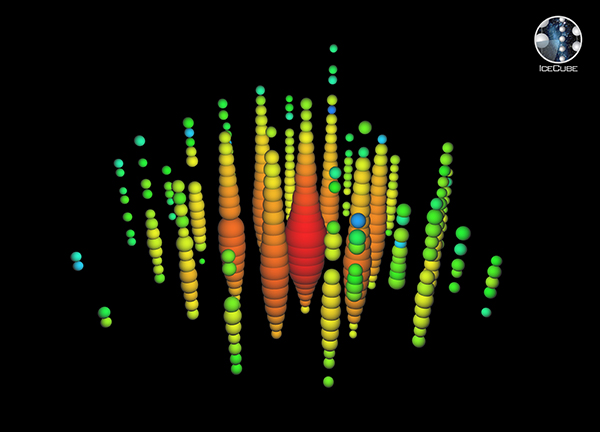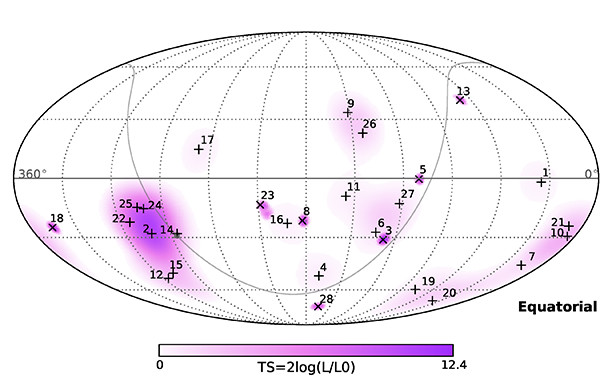
by Timothy Oleson Monday, November 25, 2013

Nicknamed 'Ernie,' the highest-energy neutrino ever observed, at 1.14 peta-electronvolts (PeV), was seen by IceCube on January 3, 2012. The second-highest-energy neutrino, nicknamed 'Bert,' had an energy of 1.04 PeV and was observed on August 9, 2011. Each blip of color in this image corresponds to the response of one of IceCube detectors. IceCube Collaboration

A skymap showing the approximate point sources of 28 high-energy neutrino events recently reported by the IceCube collaboration. IceCube Collaboration
“Deep below the glacial surface at the South Pole, where the Antarctic ice is crystal clear yet pitch black, a 3-D array of more than 5,000 custom-built and precisely positioned sensors, each about the size of a basketball, lies frozen in place.”
The above may sound like a description of an elaborate exhibition of cold-weather installation art. Actually, this was my introductory sketch in a January 2012 article for EARTH profiling the world’s newest and largest neutrino observatory — the $270-million IceCube project — the main purpose of which is to detect and hopefully identify the as-yet-only-theorized sources of exceptionally high-energy subatomic neutrinos that stream through space.
In a study published last week in Science, the members of the project, comprising about 250 scientists, laid out their case showing that the first of those goals — detection — has been accomplished. They detailed 28 detection events of neutrinos ranging in energy from about 30 tera-electronvolts (TeV) to 1.14 peta-electronvolts (PeV), far higher than for any neutrinos previously observed. (That’s 30 trillion to 1.14 quadrillion electronvolts; for reference, particles tend to be accelerated from the sun with energies ranging from thousands to billions of electronvolts.) The 28 neutrinos are suspected of having originated outside the solar system, perhaps in violent phenomena like quasars and gamma ray bursts millions to billions of light-years away.
When I spoke with IceCube principal investigator Francis Halzen, a physicist at the University of Wisconsin at Madison, and other team members for the story in August 2011, they were enthusiastic but spoke with a cautious optimism about the project. The monumental technical feat of constructing the observatory — in the works since a smaller proof-of-concept project successfully saw neutrinos in the 1990s — had been completed at the end of 2010, and smaller scientific goals had already been met, all cause for celebration. But although the partially built IceCube detector had been collecting data since 2005, the full detector had only come online in May 2011 and the team had not yet found any clear evidence for high-energy, “astrophysical” neutrinos.
“If you can definitively make a measurement of where the highest-energy neutrinos are coming from in the universe and you can start to pin down how some of [the processes that release them] work, it revolutionizes the entire field of astrophysics,” Darren Grant, a particle physicist at the University of Alberta in Canada and an IceCube team member, told me at the time.
On Thursday, in a University of Wisconsin press release, Halzen was triumphant, saying it’s “gratifying to finally see what we have been looking for,” and hailing the results as “the dawn of a new age of astronomy.” And when I contacted him again Friday, he told me the findings offered validation for the massive experiment, which had at one time been deemed impractical. “Building a neutrino observatory in the Antarctic ice was thought to be a pretty wild idea when it was first proposed” was how it was described to me in 2011 by Albrecht Karle, an associate director of IceCube also at University of Wisconsin at Madison.
Now, “we don’t have to justify spending the money anymore,” Halzen told me Friday with a chuckle. He said he and his colleagues spent a year scrutinizing the dataset — collected between May 2010 and May 2012 — not “leaving any stone unturned” to ensure they were interpreting it correctly. “In fact, some stones we turned over maybe 20 times,” he said, adding that “we are now totally confident about the results.”
And other scientists not involved with IceCube appear to agree. “2013 should be remembered as the beginning of [high-energy] neutrino astronomy,” Angela Olinto, an astrophysicist at the University of Chicago, told Popular Mechanics. And speaking to the Los Angeles Times, UCLA astrophysicist Alexander Kusenko called the findings a “landmark discovery.”
Seeing Neutrinos in the Ice
IceCube consists of 86 strands of spherical, photomultiplier-equipped sensors that were painstakingly lowered into the glacial ice, to depths between 1.5 and 2.5 kilometers below the surface, starting in 2004. Occupying about one cubic kilometer in volume, the web of sensors detects faint traces of blue light given off by muons (another subatomic particle) created when neutrinos — trillions of which stream through Earth (and each of us) all the time — collide with comparatively massive atomic nuclei in the ice.
Because the neutrinos are nearly massless and carry no electrical charge, relatively few such collisions actually occur, complicating detection. It’s these same properties, however, that allow neutrinos — unlike other particles such as charged cosmic rays, which are more easily detected but also easily deflected — to travel through space undisturbed by pesky magnetic fields and other disturbances. Thus, when neutrinos are observed, astronomers may be able to trace the linear trajectories of these “ghost particles” back to their origins.
Scientists have actually been detecting neutrinos for decades. As I wrote in my 2012 piece, though, the trick for neutrino astronomers “is to distinguish muons coming from the relatively few high-energy neutrinos from a sea of background muons, generated constantly by showers of lower-energy atmospheric neutrinos and other subatomic interactions.” That distinction is primarily what IceCube was built to do.
(Courtesy of the University of Wisconsin-Madison)
Much More to Come
And that’s what it has begun to do. “But there is much more to come … we don’t know yet where these neutrinos come from,” Halzen says. “You can think of these 28 [neutrino] events as a map of the universe with 28 pixels,” he says. To begin piecing together the particles’ origins, “we need more pixels.” Of course, the members of the IceCube team aren’t just interested in where the highest-energy neutrinos come from, but also about fundamental neutrino properties, the mystery that is dark matter, and other questions.
“The next step, scientifically, is to collect more [neutrino] events,” Halzen says, noting that the team is still in the process of analyzing a year’s worth of data not included in the recent study. Upgrades to the observatory are also in the works, he says, with plans to add more strands of detectors to the existing array to both increase its sensitivity and expand the volume of ice in which it searches for those little flashes of blue light.
It’s unclear how much more data is needed to start pinning down answers, or how long it will take. But if it takes 20 years (the original designed lifetime of the observatory), Halzen says, that’s how long IceCube will continue operating with its 5,000-plus eyes peeled.
Right now, with its first major accomplishment, “the excitement is still in the air” for the team, Halzen says. And “now that we know what we’re looking for, everything gets easier.”
© 2008-2021. All rights reserved. Any copying, redistribution or retransmission of any of the contents of this service without the expressed written permission of the American Geosciences Institute is expressly prohibited. Click here for all copyright requests.